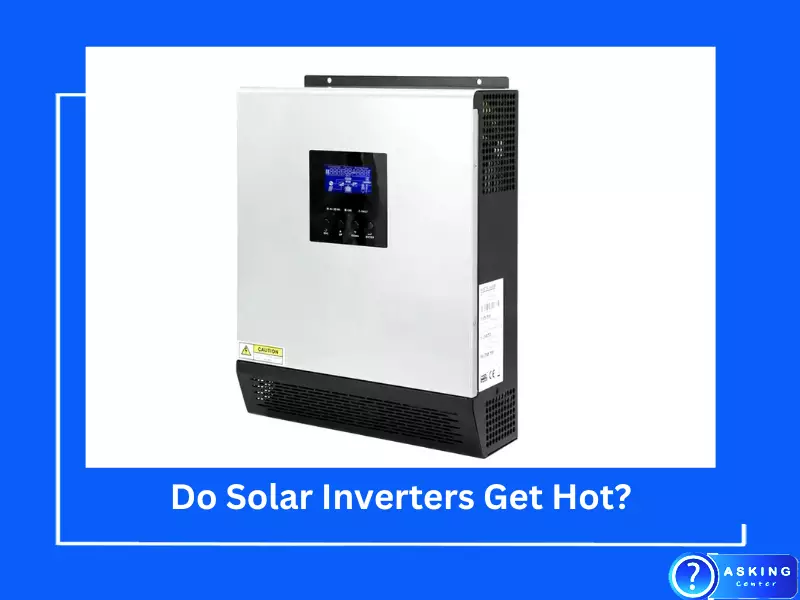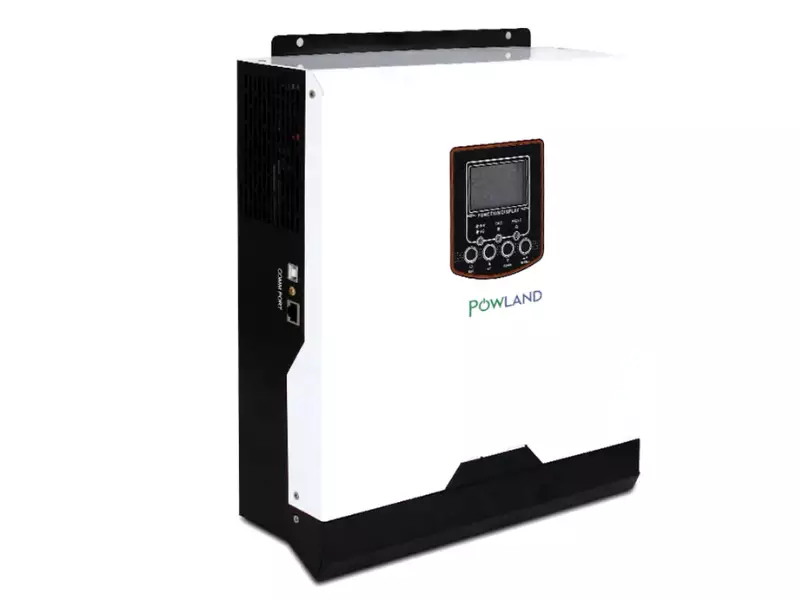Solar inverters play a pivotal role in the world of renewable energy. As the bridge that converts direct current (DC) generated from solar panels into alternating current (AC) suitable for household use, these devices are indispensable. Their critical function, however, leads many to wonder about their efficiency and operational dynamics.
Do solar inverters get hot? Absolutely, they can. Solar inverters, just like any electronic equipment, generate heat as they operate. This heat production is a consequence of electrical losses and the internal workings of the inverter during the conversion process.
Temperature management in solar inverters is more than just a matter of ensuring efficient functioning. Heat can affect performance, reduce the lifespan of the inverter, and even pose potential safety concerns. Therefore, it’s essential for users and installers to be aware of the heat dynamics associated with solar inverters.
How Solar Inverters Work
Solar energy is rapidly becoming a go-to source for many homeowners and businesses. But harnessing this energy is not just about installing solar panels; it’s about understanding the devices that make the energy usable. Enter: the solar inverter.
Basic principle of converting DC to AC
Solar panels produce direct current (DC). Our homes and most of our devices, on the other hand, operate on alternating current (AC). The solar inverter’s primary job is this transformation – converting the DC produced by the solar panels into AC that can be fed into the grid or used by our appliances.
Direct current (DC) is a unidirectional flow of electric charge. This means the electric charge flows in only one direction. On the other hand, alternating current (AC) periodically reverses direction. In many applications, AC is preferred over DC because it’s easier to generate and can be transported over long distances without significant losses.
Components responsible for heat generation
Solar inverters comprise various components, and some of these are inherently responsible for generating heat:
- Switching Components: These are electronic components that frequently turn on and off to assist in the DC to AC conversion process. Each time they switch, a small amount of energy is lost as heat.
- Transformers: If the inverter has a transformer, it can be a source of heat. Transformers work on the principle of electromagnetic induction and, during this process, produce some heat.
- Capacitors: These store and release electrical energy. In doing so, they can generate heat, especially if they are constantly charging and discharging.

Causes of Heat in Inverters
While the heat generation in solar inverters is a natural phenomenon, it’s essential to understand its root causes to address and manage it effectively.
Electrical losses and efficiency
No inverter is 100% efficient. Some of the energy, when converting from DC to AC, will inevitably be lost. This loss typically manifests itself as heat. The degree of heat generated often correlates with the inverter’s efficiency rating. For example, an inverter with a 96% efficiency rating will generally produce less heat than one with a 90% efficiency rating.
Ambient temperature effects
The environment in which the inverter operates plays a critical role in its temperature. If an inverter is placed in a location with high ambient temperatures, it will naturally run hotter than if it’s situated in a cooler environment. Direct sunlight, limited airflow, and enclosed spaces can all elevate the ambient temperature, making the inverter work in a hotter environment.
Load demand on the inverter
The amount of power being drawn from the inverter, or its load, can influence its temperature. When there’s a high demand on the inverter, it has to work harder, leading to increased heat generation. It’s similar to how a car engine might get hotter when driving uphill as opposed to cruising on a flat road. If the inverter is constantly operating at its maximum capacity, it’s more likely to get hotter than when it’s functioning below its rated capacity.

Impact of Overheating
Heat is a natural byproduct of many electrical devices, but when it comes to solar inverters, excessive heat is not just an inconvenience—it can pose significant challenges.
Reduced efficiency and performance
Solar inverters work hard to convert DC to AC. However, as the inverter heats up, its efficiency can take a hit. This reduction in performance can manifest in several ways:
- Power losses: A hot inverter may not convert solar energy to electrical energy as efficiently, leading to a decrease in the power output.
- Inconsistent power output: Overheating can lead to fluctuations in power output, which can affect the stability of the energy supplied to a home or business.
Potential damage and reduced lifespan
Excessive heat can take a toll on the inverter’s internal components:
- Wear and tear: Over time, continuous exposure to high temperatures can wear out components faster, necessitating more frequent replacements or repairs.
- Shortened lifespan: Like any electrical device, solar inverters have a finite lifespan. Operating consistently at high temperatures can cut that lifespan short, leading to premature failures.
Safety concerns
Safety should always be a top priority. Overheated inverters can present safety risks:
- Fire risks: In extreme cases, a malfunctioning inverter running too hot can become a fire hazard, especially if placed near flammable materials.
- Component failure: Overheated components can fail, causing short circuits or other electrical issues that can pose safety concerns.
Common Cooling Mechanisms
Keeping solar inverters cool is not just about maintaining performance—it’s also about ensuring they operate safely and have a long, productive life. Manufacturers incorporate several cooling methods to manage the heat produced.
Passive cooling: Heat sinks and natural airflow
Passive cooling does not rely on any external power source. Instead, it uses the natural properties of materials and airflow to dissipate heat.
- Heat sinks: These are specially designed metal structures, often made of aluminum, attached to the heat-generating components inside the inverter. Their design increases the surface area available for cooling, allowing them to dissipate heat more effectively.
- Natural airflow: Some inverters are designed with vents that promote natural airflow. As hot air rises and exits the inverter, cooler air is drawn in, helping to regulate the internal temperature.
Active cooling: Fans and liquid cooling systems
Unlike passive cooling, active cooling methods require an external power source. They actively work to reduce the temperature of the inverter.
- Fans: These are perhaps the most common active cooling mechanism. Fans circulate air inside the inverter, pushing out hot air and bringing in cooler air. They can be thermostatically controlled, activating only when the temperature reaches a certain threshold.
- Liquid cooling systems: While less common than fans, some high-performance inverters use liquid cooling. These systems circulate a cooling liquid, such as coolant or distilled water, around the inverter’s heat-generating components. The liquid absorbs the heat and is then cooled down by a radiator or other mechanism before being recirculated.

Signs Your Inverter is Overheating
Overheating in solar inverters is more than just a minor setback. Recognizing the signs of overheating can prevent potential damages, improve efficiency, and prolong the lifespan of the unit.
Physical warmth to the touch
One of the most direct indications of overheating is when the inverter becomes warm or hot to touch. It’s essential to occasionally check the inverter’s physical temperature, especially during peak solar hours. However, always ensure safety precautions while doing so.
Reduced power output
A drop in performance, particularly in power output, can indicate that the inverter is overheating. Monitoring the energy output consistently and noting any irregularities can be a strong signal that the unit might be operating at higher temperatures than desired.
Warning indicators or alarm systems
Many modern inverters come with built-in alarm systems or warning indicators. These indicators serve as a notification system for potential issues, including overheating. If the alarm sounds or if any warning lights are flashing, it’s crucial to address the situation promptly.
Prevention and Solutions
Being proactive in preventing overheating is better than seeking solutions after the damage has been done.
Proper installation and spacing
- Adequate spacing ensures that the inverter has enough room to “breathe.” It facilitates natural airflow around the unit, which can help in cooling.
- Avoid placing the inverter in tight or confined spaces.
- Ensuring that the unit is installed upright can also contribute to efficient cooling.
Regular maintenance and cleaning
- Dust and debris can block the inverter’s vents, limiting airflow and leading to heat build-up. Regular cleaning of these vents can help prevent this issue.
- A routine inspection can also identify potential issues before they become severe.
Upgrading to a more suitable inverter size or type
- If the current inverter is consistently overheating, it might be too small for the power demand. Consider upgrading to a larger inverter.
- Opting for an inverter with advanced cooling mechanisms or one designed for harsh conditions might be beneficial in extreme environments.
Factors Influencing Inverter Temperature
Several factors can influence how hot an inverter gets during operation.
Inverter quality and build
Not all inverters are created equal. The quality of components and build plays a significant role in how efficiently an inverter can handle heat. High-quality inverters often come with better heat dissipation mechanisms, ensuring they remain cool even during peak operation.
Installation environment: shade, indoor vs outdoor
- Shade: Placing the inverter in a shaded area can significantly reduce its exposure to direct sunlight and, as a result, reduce its operating temperature.
- Indoor vs. Outdoor: Outdoor inverters are designed to handle various environmental conditions, but they can still get quite hot, especially in direct sunlight. Indoor inverters, on the other hand, are often shielded from the elements, but they require proper ventilation to avoid overheating.
Local climate conditions
The local climate has a direct impact on the inverter’s operating temperature. In areas with hot and sunny conditions, the inverter is naturally prone to overheating. Conversely, in cooler regions, the ambient temperature can assist in keeping the inverter’s temperature down.
Frequently Asked Questions
Why do solar inverters generate heat?
The heat generated by solar inverters primarily stems from electrical losses that occur during the conversion of DC to AC. It’s a natural byproduct of the electrical resistance and the inefficiencies inherent in the conversion process.
How can I tell if my solar inverter is overheating?
Solar inverters that are overheating might become warm or hot to the touch. Additionally, many modern inverters come equipped with warning indicators or alarm systems that notify users when temperatures reach concerning levels.
Can excessive heat damage my solar inverter?
Yes, prolonged exposure to excessive heat can reduce the lifespan of a solar inverter, diminish its performance, and in severe cases, even cause it to fail or pose safety hazards.
Conclusion
The role of solar inverters in renewable energy systems is undeniable. As they bridge the gap between solar-generated power and everyday electrical needs, understanding their operational intricacies becomes paramount.
The heat generated by solar inverters, while a natural aspect of their functioning, can have far-reaching implications if not managed properly. While technological advancements and quality manufacturing practices aim to minimize these issues, awareness remains the first line of defense.
To ensure longevity, optimal performance, and safety, periodic checks, suitable installation environments, and regular maintenance are essential for every solar inverter. As renewable energy adoption grows, such diligence will ensure we reap the benefits efficiently and safely.
